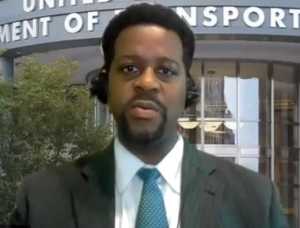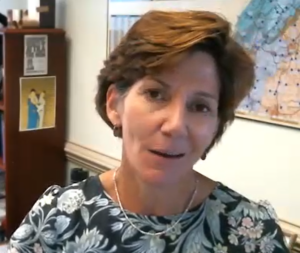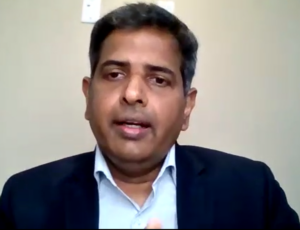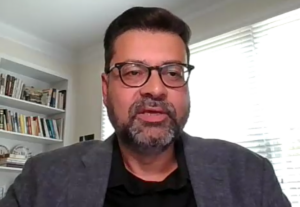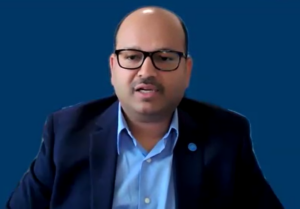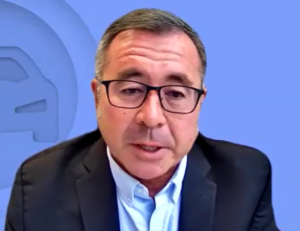
Safety No. 1 priority of V2X, PII privacy & consumer protection also on officials’ minds
By onTechnology
Transportation, automotive, and telecommunications officials agreed on Wednesday that safety should be the No. 1 priority in developing vehicle-to-everything (V2X) standards for connected vehicles and infrastructure, adding that PII protection is also essential.
The panel gathered to discuss progress made in V2X implementation and the road ahead on standards to govern their use.
A brief overview of the U.S. Department of Transportation’s (USDOT) V2X progress was given by Deputy Assistant Secretary for Research and Technology Robert Hampshire and at the state level by Virginia DOT Chief Deputy Commissioner Cathy McGhee.
The rest of the webinar included a Q&A between the Alliance for Automotive Innovation (Auto Innovators) and Suman Sehra, HARMAN Automotive product and innovation connected vehicle and infrastructure vice president; Jim Misener, Qualcomm product management senior director and V2X global ecosystem lead; Pom Malhotra, Audi senior director for connected services, and Ajay Rane, Amazon Web Services, IoT Business Development and Strategy global head – Telco BU.
Hampshire said following the first part of Auto Innovators’ “Connecting Cars: Realizing the Benefits of V2X,” held last year, led to the kickoff of a new interoperability connectivity program, including several summits with transportation stakeholders.
“This progress in working with all our transportation stakeholders inspired the USDOT to further collaborate with more stakeholders to lead to the development of a new vision and comprehensive plan for interoperable nationwide deployments,” he said.
McGhee said it’s frustrating where the country is as a whole on large-scale V2X deployment after so much monetary and energy investment.
“We’ve been fairly limited in what we’ve been able to do,” she said. “We keep waiting for the day where we have that large-scale deployment and we can really, really begin to quantify benefits on a larger scale. But we’ve had successes along the way.”
One success she named was the testing of dedicated short-range communications (DSRC) with signal phase and timing (SPaT) broadcast in real-time to warn drivers of any dangers ahead of them so they can take action to avoid a wreck. Doing so involves vehicle-to-vehicle and vehicle-to-infrastructure communications.
The test was conducted on Route 50 in northern Virginia to enable red light violation warnings, green light optimized speed advisories, and work zone information sharing.
She and Hampshire both said there is work to be done moving ahead to develop universally accepted architecture and road maps for V2X to be interoperable so that everyone is on the same page. McGhee said she’s interested to see what OEMs will do to embrace connected and automated vehicles as opposed to just automation. Telecommunications will have to be the bridge to get to where V2X should be, she added.
Rane said, however, V2X — both in vehicle-to-vehicle (V2V) and vehicle-to-everything (V2I) — comes with data privacy, authentication, and verification concerns that if not handled carefully could lead to unintended consequences and open up access to vehicles and infrastructure for malicious activity. When the same model vehicles are communicating there will be additional security but that diminishes when multiple vendors communicate over a reference standard or common architecture.
“When we look at how we’re developing the technology, we need to look at PII authentication as well as, just in general, policy around that,” he said.
Misener added that while safety and trust are fundamental there’s also an element of equity and a matter of convenience to consider.
“Certainly, as a traveling public, you may not care about what technology is in there,” he said. “What you care about this is that it facilitates a trip that you want to make, that your loved ones want to make, and that another person wants to make so you don’t encounter anything except for pleasant cooperation.”
Audi began the development of V2V technology in 2016, which began as driver traffic light notifications, Malhotra said.
“This was interesting because it provided a way to look at how do you give the driver more information than they would otherwise have? And what does that actually do? And the observable benefits of doing that is definitely adding to the level of comfort that somebody feels while driving,” Malhotra said. “Because if you know that your vehicle is telling you that a light is going to turn red by the time you get to that intersection, your behavior changes; you normally… come to a slow stop versus, ‘Am I dashing through this intersection or coming to a screeching halt?’ decision when you see the amber light.
“The only difference between the normal scenario and this scenario is that one countdown that shows up in your vehicle dashboard telling you how long before that light turns red.”
Now, there is a focus on preventing collisions including with vulnerable road users, such as children, pedestrians, and bicyclists with the next step being autonomous mobility technologies, he added.
“We’ve been in the V2X game for some time,” Malhotra said. “We’ve been using technology that leverages cellular networks for some time. This is a different game. This is now direct communications where you’re talking about not necessarily being dependent on this infrastructure or the round trip but being able to communicate directly. And as a result, you take away a lot of that latency, which can come in the way a lot of times drivers are in situations where they’re either not aware or they’re not able to see the danger on the road.”
Audi believes V2X cellular technology is what everyone should invest in and what the OEM is working on with Qualcomm, Virginia Tech Transportation Institute (VTTI), VDOT, and others as well as internally, he said.
“The automaker being the one that the customer is closest to, we have a role to play,” Malhotra said. “I think we are also the best positioned to bring this ecosystem together.”
Sehra said HARMAN sees the rollout of V2X as occurring successfully only after state agencies, automakers, and others are able to deploy it within the 5.9 gigahertz band, called the Safety Band by USDOT. It’s reserved for only transportation-related communications. He noted the FCC’s decision, which was made in November 2020, to make new spectrum within the band available for unlicensed uses, such as Wi-Fi, and enhanced automobile safety using Cellular Vehicle-to-Everything (C-V2X) technology.
Sehra called that a watershed moment. Waivers and grants made available through the Bipartisan Infrastructure Law have also been fundamental, he said.
Misener agreed, saying that more joint waivers need to be granted as well as a final rule on V2X standards.
“No longer [do] we have to contend dealing with two protocols,” he said. “I think that antiquity, as a product owner, ‘do I supply my products that conform to this stack or that?’ created a lot of confusion. And also the lack of regulation or lack of clarity has been a bit of a challenge.
“Now, at least we can say this is a step forward for not just the industry but also for the road users, the city planners, the highway administrators, the independent parties that are involved who can actually experience the enhanced roadway safety and the traffic or mobility efficiency benefits, which you could only think of when you are really setting up a blueprint of a smart city. Now, to be truly successful, these connected experiences must be thoughtfully translated and engineered.”
Doing so should include a focus on data security, durability, consumer trust in the safety of autonomous technology within and outside of vehicles, and the general effectiveness within an automotive environment, he added.
Malhotra called on NHTSA to engage in a stronger way to address the country’s increased number of vulnerable road user fatalities. In addition, there should be continued leadership on developing a national V2X roadmap strategy, he said.
Images
Featured image: Stock illustration of V2X technology. (Credit: metamorworks/iStock)
Headshots screen captured during webinar on Sept. 13, 2023.
More information
Federal grants help cities improve EV, connected vehicle infrastructure

